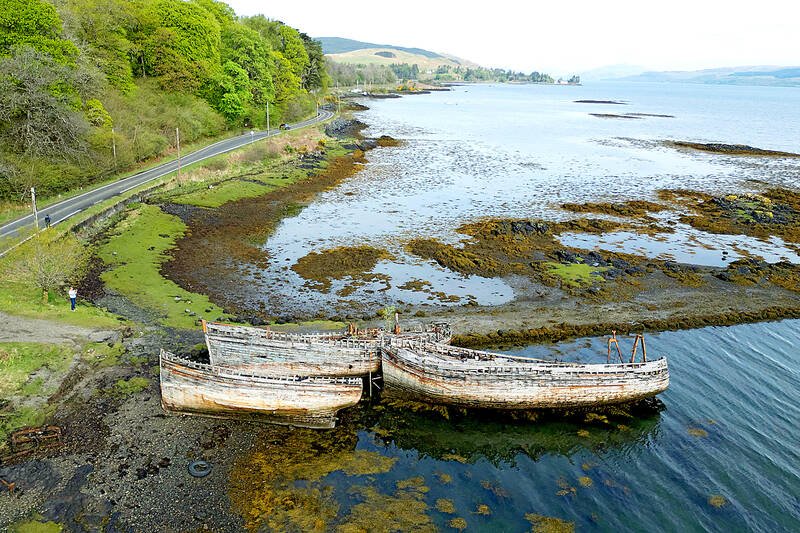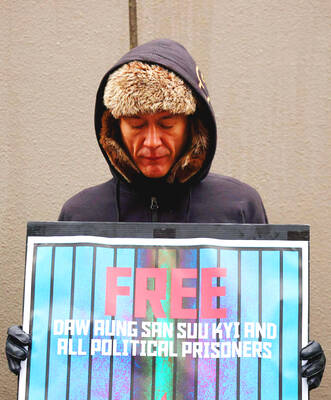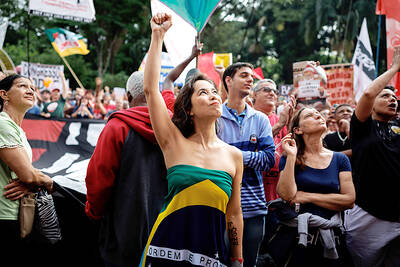The Book of Kells was likely to have been created 1,200 years ago in Pictish eastern Scotland, rather than on the island of Iona, according to research that challenges long-held assumptions about one of the world’s most famous medieval manuscripts.
The Book of Kells is an intricate, illuminated account of the four Gospels of Matthew, Mark, Luke and John that was long thought to have been started in the late eighth century at the monastery on Iona before being taken in the ninth century to the monastery of Kells in County Meath, Ireland, after a Viking raid.
It has been at Trinity College Dublin since the 17th century.

Photo: AFP
British archeologist and art historian Victoria Whitworth, who would publish evidence in a forthcoming book, said: “The Picts were great artists, producing highly sophisticated Christian sculpture, but it has generally been accepted that not a single Pictish manuscript survives. If the Book of Kells was made in Pictland, this rewrites our understanding of early medieval Scotland.”
Her research has led her to conclude that a monastery in Portmahomack, Easter Ross, northeast of Inverness, is “the most likely place for it to have been made.”
Its monks were manufacturing vellum — the calfskins on which manuscripts were written — as well as creating elaborate carvings with complex inscriptions that match those of Kells, unlike manuscript and carved inscriptions from Iona, which reflect “plainness and legibility,” she said.
Whitworth said that while the Kells monastery was founded in 807AD, it did not become important until the later ninth century.
“This is too late for the Book of Kells to have been made at Kells. The Iona hypothesis, while worth testing, has no more intrinsic value than any other,” she said.
Portmahomack flourished as one of the earliest Christian sites in the land of the Picts from about 700 to 800, when it was destroyed by fire, possibly in a Viking raid.
Whitworth said archeologists had discovered a fine sculptor’s chisel at the site of the monks’ vellum workshop, suggesting that book-making and stone-carving were intimately interlinked.
She pointed to a stone carving — part of a larger cross-slab now in the National Museums Scotland — whose Latin inscription has parallels with the text of the Book of Kells : “It is the most elaborate piece of carved stone from anywhere in the early Middle Ages in the British Isles. It [has] a long Latin inscription in relief, very beautiful lettering that’s very similar to Kells ... these fabulous display capitals.”
“The art of the Book of Kells is very different from the Iona stone sculpture, which, while high quality, lacks this endless inventiveness and unpredictability,” she said.
It was not until the 1990s that Portmahomack was discovered to have been the site of a major Pictish monastery, through archeological excavations led by Martin Carver, emeritus professor of archeology at the University of York, and published in 2016.
Whitworth said previous academics had argued that the script of the book looked far more like that of manuscripts associated with the Northumbrian island monastery of Lindisfarne than anything associated with Ireland.
“The Northumbrian monks are known to have mentored the Picts. However, until recently there had been no Pictish monastery to link it to, and these suggestions were ignored or dismissed. The Picts had suffered for many decades from being seen as mysterious, remote and backward,” she said.
“If you just look at the archeology of our top early medieval monasteries, Portmahomack stands out as exceptionally literate and book-orientated,” she said. “The standard books will say there are no Pictish manuscripts. We need to flip that on its head and say that the Book of Kells is actually an exceptionally Pictish-looking manuscript.”
Whitworth, who specializes in the art, literature and archeology of Britain and Ireland 700AD to 1100AD, would publish her research in her book The Book of Kells: Unlocking the Enigma, to be published next month.

The Burmese junta has said that detained former leader Aung San Suu Kyi is “in good health,” a day after her son said he has received little information about the 80-year-old’s condition and fears she could die without him knowing. In an interview in Tokyo earlier this week, Kim Aris said he had not heard from his mother in years and believes she is being held incommunicado in the capital, Naypyidaw. Aung San Suu Kyi, a Nobel Peace Prize laureate, was detained after a 2021 military coup that ousted her elected civilian government and sparked a civil war. She is serving a

‘NO AMNESTY’: Tens of thousands of people joined the rally against a bill that would slash the former president’s prison term; President Lula has said he would veto the bill Tens of thousands of Brazilians on Sunday demonstrated against a bill that advanced in Congress this week that would reduce the time former president Jair Bolsonaro spends behind bars following his sentence of more than 27 years for attempting a coup. Protests took place in the capital, Brasilia, and in other major cities across the nation, including Sao Paulo, Florianopolis, Salvador and Recife. On Copacabana’s boardwalk in Rio de Janeiro, crowds composed of left-wing voters chanted “No amnesty” and “Out with Hugo Motta,” a reference to the speaker of the lower house, which approved the bill on Wednesday last week. It is

‘EAST SHIELD’: State-run Belma said it would produce up to 6 million mines to lay along Poland’s 800km eastern border, and sell excess to nations bordering Russia and Belarus Poland has decided to start producing anti-personnel mines for the first time since the Cold War, and plans to deploy them along its eastern border and might export them to Ukraine, the deputy defense minister said. Joining a broader regional shift that has seen almost all European countries bordering Russia, with the exception of Norway, announce plans to quit the global treaty banning such weapons, Poland wants to use anti-personnel mines to beef up its borders with Belarus and Russia. “We are interested in large quantities as soon as possible,” Deputy Minister of National Defense Pawel Zalewski said. The mines would be part

Cozy knits, sparkly bobbles and Santa hats were all the canine rage on Sunday, as hundreds of sausage dogs and their owners converged on central London for an annual parade and get-together. The dachshunds’ gathering in London’s Hyde Park came after a previous “Sausage Walk” planned for Halloween had to be postponed, because it had become so popular organizers needed to apply for an events licence. “It was going to be too much fun so they canceled it,” laughed Nicky Bailey, the owner of three sausage dogs: Una and her two 19-week-old puppies Ember and Finnegan, wearing matching red coats and silver